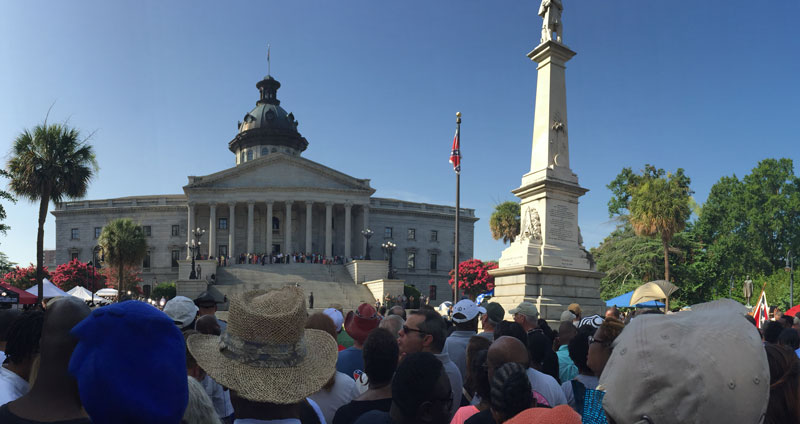
COLUMBIA—In less than a minute, the Confederate flag was gone.
Without a sound, the small square of red, white and blue cloth slid down through the bright humid air and into the hands of a state law enforcement honor guard.
Fifty years of fighting over its presence on the Statehouse grounds was over.
Thousands of people jammed the streets around the state capitol on July 10 for the brief morning ceremony.
There were no official speeches, no music, no fanfare at all. A law enforcement officer quietly handed the furled flag to Allen Roberson, director of the S.C. Confederate Relic Room and Military Museum, where it will now be housed.
As it came down, some cheered, chanted or sang. Two women broke into a verse of “Amazing Grace.” Others who carried or wore images of the flag stood in stony silence.
But no violence nor conflict surrounded its removal, which activists had sought for decades.
It finally came in the wake of tragedy after the June 17 shootings of nine people at Emanuel AME Church in Charleston by a man who called himself a white supremacist and said he wanted to start a race war.
 Reminders of the “Emanuel Nine,” as some now call them, were present in the crowd. Ernest Lee, a popular Columbia artist known as “Chicken Man,” displayed a portrait of the men and women that he plans to take to Charleston to present to the church. Columbia resident Cynthia McDuffie proudly wore a shirt that said simply “Pray for Charleston.”
Reminders of the “Emanuel Nine,” as some now call them, were present in the crowd. Ernest Lee, a popular Columbia artist known as “Chicken Man,” displayed a portrait of the men and women that he plans to take to Charleston to present to the church. Columbia resident Cynthia McDuffie proudly wore a shirt that said simply “Pray for Charleston.”
Many expressed gratitude and relief that the banner was removed without incident.
“While the flag is a symbol of pride for some people, it’s a symbol of pain for others, and it’s important that as fellow human beings we finally realized that,” said the Rev. Zachary Dillard, associate pastor of Columbia’s Trenholm Road United Methodist Church.
“It’s important that people with different opinions stood out here together and stood as one today without any violence,” said Vic James, 28, of Columbia.
Parents called the event an important teaching moment.
Victoria Wright of Columbia brought her three daughters: Marielle, 8; Cherish, 7; and Mahoganie, 4.
“I thought this was never going to happen, and now that it is I wanted them to see history going down,” she said.
Zion Askins, 16, came to the ceremony with his mother Keia Askins-Wise of Columbia.
“It’s great to be able to witness something so big,” he said. “And I’m glad to see the flag coming down. I think it would be good if we could all be proud of the United States flag now and focus on that rather than something that belongs to history.”
After the emblem came down, the few disagreements and discussions that broke out were civil.
 Michael Lucas of Virginia, who held a large Confederate flag, stood near the base of the Confederate memorial and disputed points of history with Cedric Shelby, who traveled all the way from Sacramento, California, to witness the event.
Michael Lucas of Virginia, who held a large Confederate flag, stood near the base of the Confederate memorial and disputed points of history with Cedric Shelby, who traveled all the way from Sacramento, California, to witness the event.
“We’re both veterans, and we both fought for each other’s right to have an opinion and disagree,” Lucas said.
Some in the crowd had spent the weeks since the Charleston shooting standing in the hot sun for hours to protest the flag’s presence.
Kira Biears, 21, of Greenville, came to the grounds 17 days in a row to show her anti-flag stance. Biears first noticed it while walking to classes at the nearby University of South Carolina and was shocked to learn the history behind it.
“My heart changed when I learned about what it stood for and I felt very passionate about bringing it down,” she said. “Being out here the past few weeks, I’ve met people from both sides and it’s almost like we’ve become a new family. I just hope that now the flag is done, people on both sides can come to terms with things, learn to respect each other and move on.”
Tom Clements, a Georgia native who now calls Columbia home, carried a poster with photographs of his ancestors, who fought for the Confederacy during the Civil War and saw action in some its most famous battles.
“I’ve been wanting this flag down for 50 years because of what it stands for,” he said. “I don’t disrespect my ancestors and the others who fought in the Civil War, but I do think the cause they fought for was wrong. We’ve been fighting this war for 150 years and now it can come to an end. My ancestors and the others can rest in peace.”
People stood in small groups near Gervais Street for a while after the event, talking, hugging each other, taking pictures and occasionally glancing up at the now-empty flag pole, which was removed later in the afternoon.
Above them, in the blue sky, the U.S. flag and the South Carolina flag flapped slightly in a hot breeze, in their place of honor atop the capitol dome.
RELATED: Confederate flag replaced by hopes for healing
Feature photo: Miscellany/Christina Lee Knauss
Photos: Miscellany/Deirdre C. Mays

